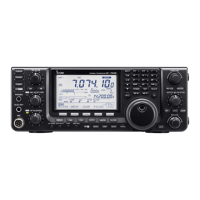69
MEMORY OPERATION
7
■ General description
The transceiver has 101 Memory channels (99 regular,
and 2 scan edges). The Memory mode is very useful
to quickly change to often-used frequencies.
While in the memory mode, all 101 Memory channels
are tunable, which means the programmed frequency
can be tuned temporarily with [DIAL].
Memory Channels Descriptions
1–99 Regular Memory channels with Split frequency capability.
P1, P2
Program Scan Edge Memory channels with only Simplex capability.
Stores the scan edge frequencies for the programmed scan.
D Memory channel contents
The following information can be programmed into
Memory channels:
•Operatingfrequency(p.26)
•Operatingmode(p.31)
•IFlternumber(p.57)
•Splitdata(p.66)
•Memoryname(p.73)
•Repeatertoneencoder(p.51),ortonesquelchON/
OFF (p. 50)
•Repeatertonefrequency(p.52)ortonesquelchfre-
quency (p. 50)
NOTE:
Memory data can be erased by static electricity, elec-
tric transients, etc. In addition, they can be erased by
malfunction and during repairs. Therefore, we recom-
mend that memory data be backed up.
■ Memory channel selection
D Selection in the VFO mode
q Push [VFO/MEMO] to select the VFO mode.
w Push [Y] or [Z] to select a Memory channel num-
ber.
•AllMemorychannels,includingblankchannels,canbe
selected.
•“
” appears when no information has been pro-
grammed into the Memory channel. (Blank channel)
e Push [VFO/MEMO] to select the Memory mode.
•“MEMO”andcontentsoftheMemorychannelappear.
D Selection in the Memory mode
q Push [VFO/MEMO] to select the Memory mode.
w Push [Y] or [Z] to select a Memory channel.
•AllMemorychannels,includingblankchannels,canbe
selected.
•“
” appears when no information has been pro-
grammed into the Memory channel. (Blank channel)
•Memorychannelscanalsobeselectedusingthemicro-
phone [UP]/[DN] keys. In such case, the blank channels
are skipped.
While in the VFO mode
Appears if the selected Memory
channel has no information.
While in the Memory mode

